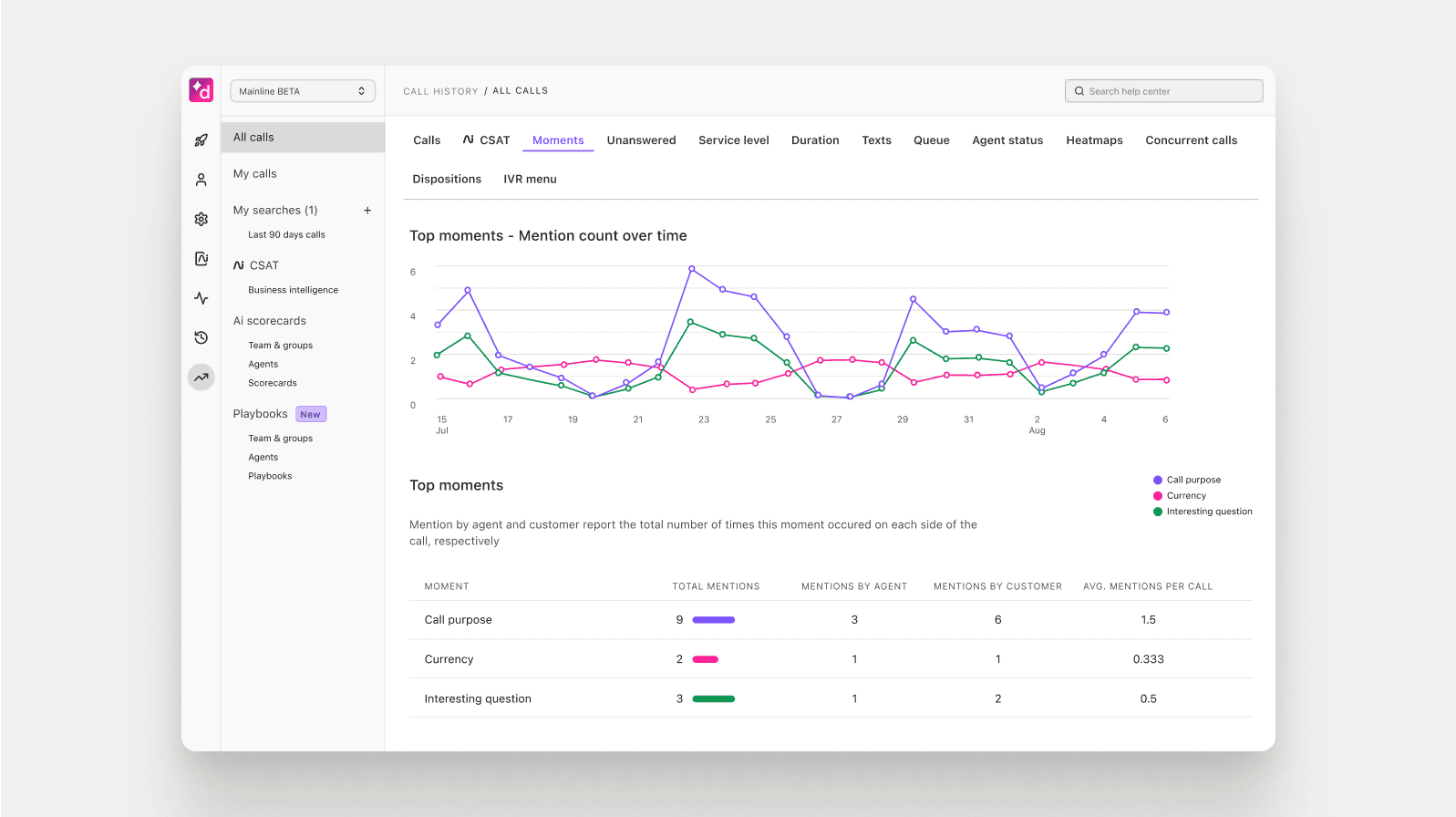
Tags
Share
Predictive analytics uses historical data, machine learning, and statistical modeling to forecast future outcomes. In contact centers, this means anticipating customer needs, predicting call volumes, and identifying patterns in agent performance—so your teams can take proactive steps before issues arise.
By analyzing past interactions and behaviors, predictive analytics helps contact centers make smarter, data-driven decisions that improve both customer experiences and business outcomes.
How do predictive analytics work in a call center?
Predictive analytics typically operate by turning historical raw data into actionable intelligence that you can use to impact future performance. In a contact center environment, this process results in more accurate forecasting, better resource allocation, and more personalized support. Here’s how it works, using Dialpad’s contact center platform as an example:
Data collection: Dialpad captures data across external and internal communication channels including voice calls, texts, and digital messaging channels like WhatsApp. This multi-channel data is crucial because it provides a full picture of the customer journey and uncovers signals that might be missed if you’re relying on just a single channel.
Data analysis: Dialpad AI analyzes this data to detect trends, patterns, and anomalies, uncovering hidden insights that drive better decisions. These insights can highlight areas like common customer complaints, peak call hours, or agent behaviors that impact resolution times.
Prediction: Using natural language processing (NLP) and machine learning, Dialpad AI can make accurate predictions—for example, inferring customer satisfaction scores for up to 100% of conversations, without needing customers to fill out CSAT surveys (which generally only the happiest and angriest customers do). Essentially, this AI CSAT feature solves the two biggest issues with CSAT surveys: low response rates and biased responses.
Actionable insights: Finally, Dialpad AI provides real-time summaries and guidance, such as pulling relevant content and talking points for agents or alerting supervisors to low customer sentiment or lack of compliance adherence. These live prompts help agents respond more effectively during live interactions, and improve both customer satisfaction and compliance.
👉 Dialpad tip:
Learn more about how teams can use Dialpad’s contact center analytics to make smarter decisions.
Types of call center analytics
Call centers rely on several types of analytics to operate efficiently. Each plays an important role and there may sometimes be overlap as well. For example, an AI feature that tracks how often a keyword is spoken in customer conversations can be considered both a form of speech analytics and interaction analytics.
Together, all of these analytics create a holistic view of customer and agent activity that improves service quality and operational effectiveness. Here are a few types of analytics that most contact centers monitor:
Predictive analytics: Forecasts future trends like call volumes or customer churn using historical patterns, enabling proactive planning and resource management.
Example: A retail call center uses predictive analytics to anticipate a surge in calls after a holiday promotion goes live.
Speech and text analytics: Analyzes live and recorded conversations to identify common themes, sentiment, and compliance issues.
Example: A bank uses speech analytics to flag calls where phrases like "cancel my account" are said, helping retention teams follow up quickly.
Interaction analytics: Tracks the customer journeys across channels, revealing patterns that help optimize workflows and improve resolution rates. If you don’t have the resources yet to uncover quantitative analytics, an alternative is to use qualitative insights into customer interactions, such as call summaries, for now. AI features like Dialpad’s Custom Moments help contact centers track how frequently certain keywords, like “refund” or “cancel” are spoken in customer conversations. This can provide useful context and insight in place of (or as a complementary piece to) hard numbers.
Example: A telecom provider uses interaction analytics to identify customers who first reached out via chat but later had to call in, which may signal a gap in self-service effectiveness.

Agent performance analytics: Monitors agent activity and call outcomes to reveal opportunities to provide more targeted coaching, improve efficiency, and ensure consistent service quality.
Example: A healthcare call center reviews agent analytics to understand which team members have longer average handle times and tailors coaching accordingly.
Use cases for predictive analytics in contact centers
Predictive business analytics support a wide range of industries by enabling more personalized, efficient, and proactive customer support. But beyond support, predictive analytics can support churn and revenue goals as well. Long story short, if a line of business needs to be able to forecast future demand or sales, they should consider predictive analytics solutions.
Here’s are a few industry examples:
Healthcare: With predictive analytics, contact centers in healthcare can forecast patient call surges more accurately, which allows them to ensure adequate staffing, reduce wait times, and improve patient outcomes. Analytics tools can also help with identifying trends in scheduling or symptoms, and support providers in intervening earlier and delivering more responsive care.
Business Process Outsourcing (BPO): For BPO teams, predictive analytics can help with anticipating workload shifts and adjusting staffing accordingly. This is essential for optimizing agent schedules and maintaining SLAs across different clients and industries. The result: improved operational efficiency, reduced labor waste, and stronger client retention.
Finance: Financial institutions can use predictive analytics to detect signs of client churn and anticipate call spikes driven by market events. This enables advisors and teams to proactively engage clients before issues escalate, improving retention and reducing client attrition.
Telecom: Similarly, predictive analytics help telecom providers forecast service issues or spikes in network-related inquiries more effectively. As far back as 2018, McKinsey was already highlighting how predictive models were helping telecom organizations detect service degradations early on, anticipating network disruptions when performance would fall below a certain level. One provider in particular used predictive analytics in its contact center to accurately anticipate the top three categories of incoming tickets for about 80 percent of all calls, which helped its engineers reduce the time needed to troubleshoot problems by 15 percent.
General customer support: Support teams can use predictive analytics to not only identify urgent issues and route high-value customers to the right agents faster, they can also use these insights into customer behavior to personalize interactions more effectively. Beyond reducing handling times, this also improves overall service quality.
Retail and ecommerce: Retailers can use predictive analytics to forecast call spikes tied to seasonal promotions, product recalls, or inventory shortages. These insights help contact centers prepare for high-demand periods and tailor messaging based on buying behavior, which improves customer satisfaction and drives more sales.
Travel and hospitality: Airlines, hotels, and travel platforms use predictive analytics to anticipate disruptions caused by weather, cancellations, or surges in demand during peak seasons. Contact centers can then proactively reach out to impacted customers with alternative options to minimize frustration and strengthen brand loyalty.
What are the business benefits of predictive analytics?
The biggest benefit of predictive analytics is they help contact centers stay one step ahead. With real-time insights and automated recommendations, your agents and supervisors are better equipped to deliver better customer experiences while streamlining operations.
Here’s a closer look at the benefits of predictive analytics in customer service:
Improved customer experience – Predictive analytics provide insights that help agents anticipate customer needs and offer faster, more relevant support—often, before they have to ask. For example, with AI coaching, agents can get real-time tips and recommendations that help them handle complex conversations with confidence during calls.
Some predictive models can even identify when a customer is likely to churn or needs urgent assistance, which allows agents or supervisors to intervene early, creating a more personalized, empathetic experience that builds trust and loyalty.Increased efficiency – Another benefit of predictive analytics is they make workforces more efficient. Real-time contact center reporting is useful and important, but knowing when things might get hairy ahead of time (for example, being able to predict how much call volumes might increase after a new product launch) is vital for helping contact center managers optimize workforce management, reduce idle time, and boost productivity.
Reduced wait times – For businesses struggling with on-hold or wait times, predictive routing and scheduling can be a useful tool to get customers the answers they need more quickly (and increase satisfaction scores). Instead of reacting to spikes in call traffic, contact centers can plan ahead—automating queue management or prioritizing high-value customers.
Get started with predictive analytics in your contact center
You don’t need a huge team or budget to get started with predictive analytics. The key is to begin with the data you already have—like call recordings, agent activity logs, and customer interaction histories—and work with tools that can surface actionable insights from these sources.
Platforms like Dialpad Support make it easier to turn that data into real-time recommendations and long-term strategy. Start small by applying predictive analytics to a single use case, like staffing or churn forecasting, and expand as your team gets more comfortable. The sooner you adopt predictive analytics, the sooner your contact center can go from reactive to truly proactive.
Ready to future-proof your contact center with predictive analytics?
Get in touch today to see how businesses across a wide range of industries are using Dialpad’s contact center analytics to turn data into action. Or, take an interactive tour of Dialpad’s contact center platform first!

